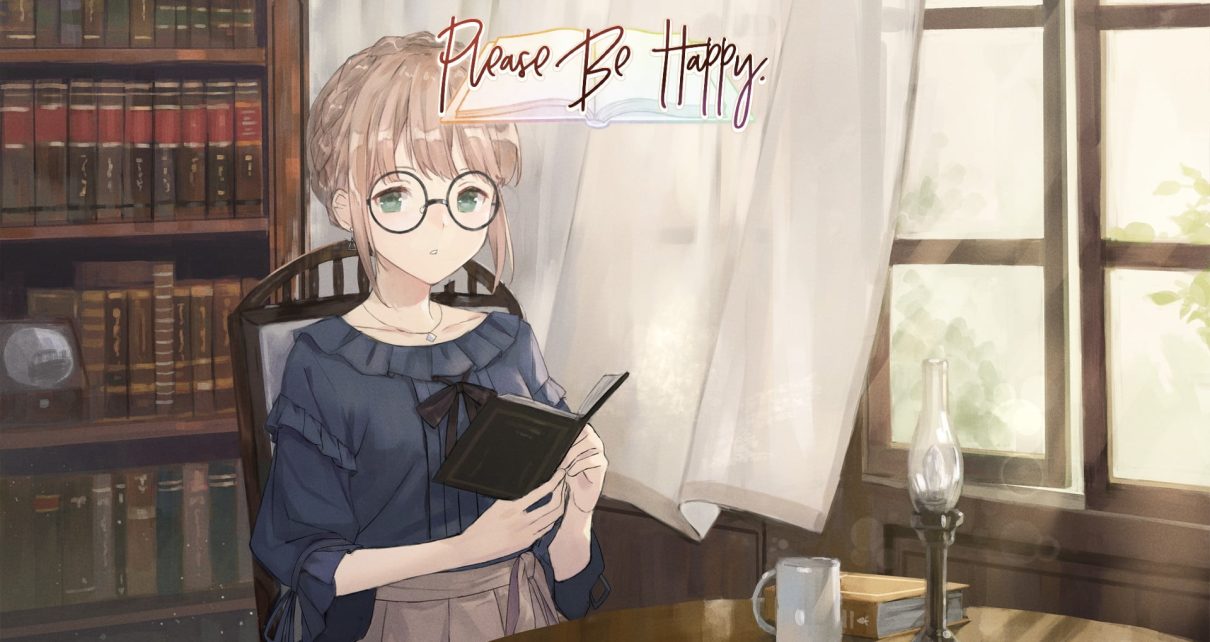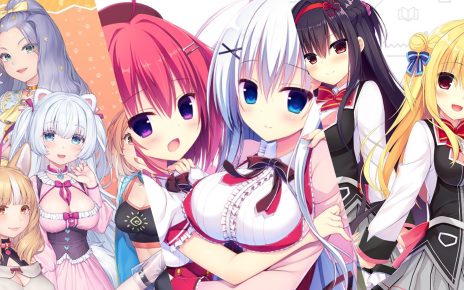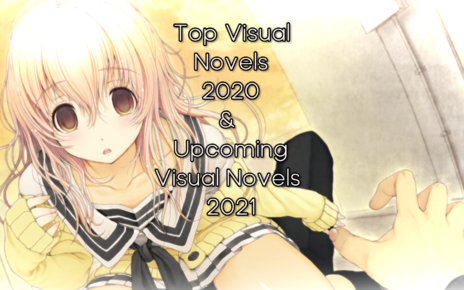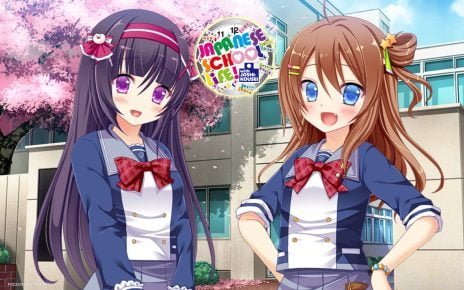Please Be Happy is an English language yuri visual novel developed by Studio Élan, who you may know for their previous works Highway Blossoms and Heart of the Woods. The story follows Miho, a fox girl with unusual magic behind her existence, as she settles into a new life in a fictionalized version of Wellington, New Zealand. Please Be Happy promises a comfy slice-of-life tale of love and friendship, which sounds lovely, but does it deliver?
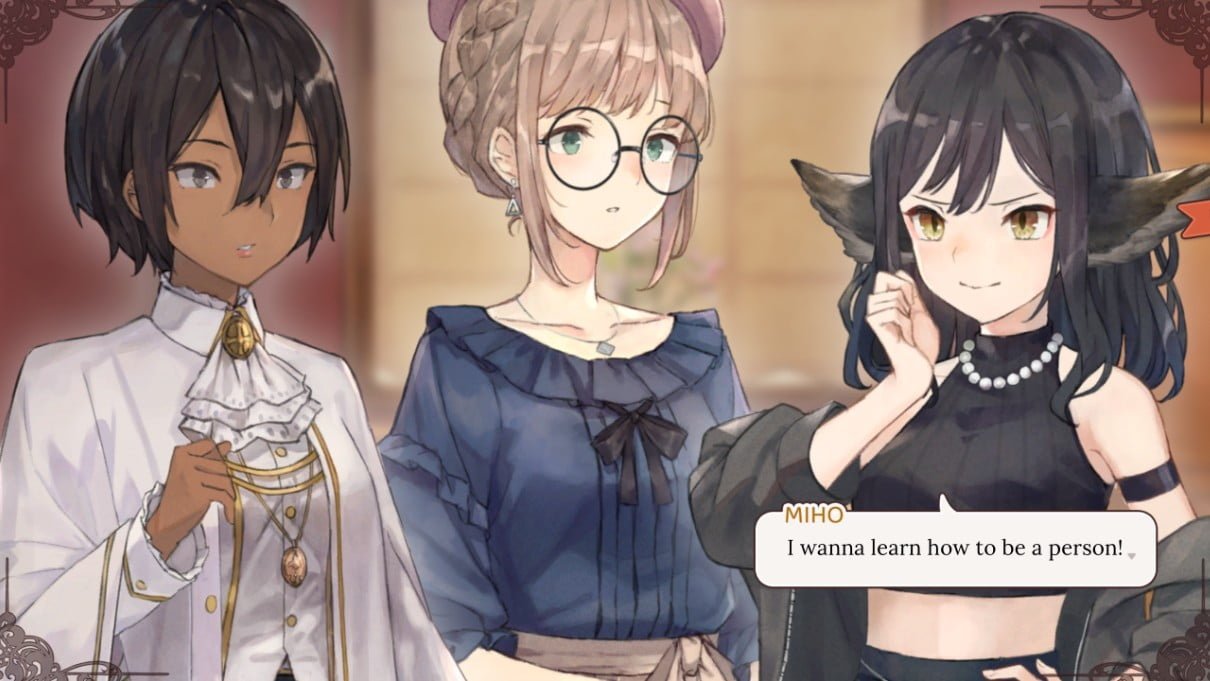
Presentation & Technical Stuff
Where Please Be Happy sets itself apart almost immediately is in the quality of its presentation and interface. The menu screens are gorgeous, but still simple and snappy to navigate. As you peruse through options, saves, and the gallery, spirited voice lines from the three central characters offer comment. It’s a small but charming touch that fits Please Be Happy’s mood nicely.
In the options, you’ll find a suite of familiar features to toggle and slide with. Of note here is the all-too-uncommon 1440p support which is a blessing in a visual novel as pretty as Please Be Happy. For games in general support for higher resolutions isn’t all that odd or impressive, but for visual novels it’s something to celebrate. The second notable option is the inclusion of the Open Dyslexic font, which as I understand it is designed to be more readable for those with dyslexia and can be quite helpful. It’s a fantastic accessibility feature worth commending, especially in such a text-heavy medium.
In play, the presentation remains impressively high quality. Dialogue appears in speech bubbles alongside character sprites, whilst descriptive text and Miho’s internal monologue appears in the traditional location across the bottom of the screen. The use of speech bubbles feels natural and doesn’t hamper readability. There were a couple of occasions I got confused by the order of speech but I think you can put that down to my incompetence rather than any fault with the game.
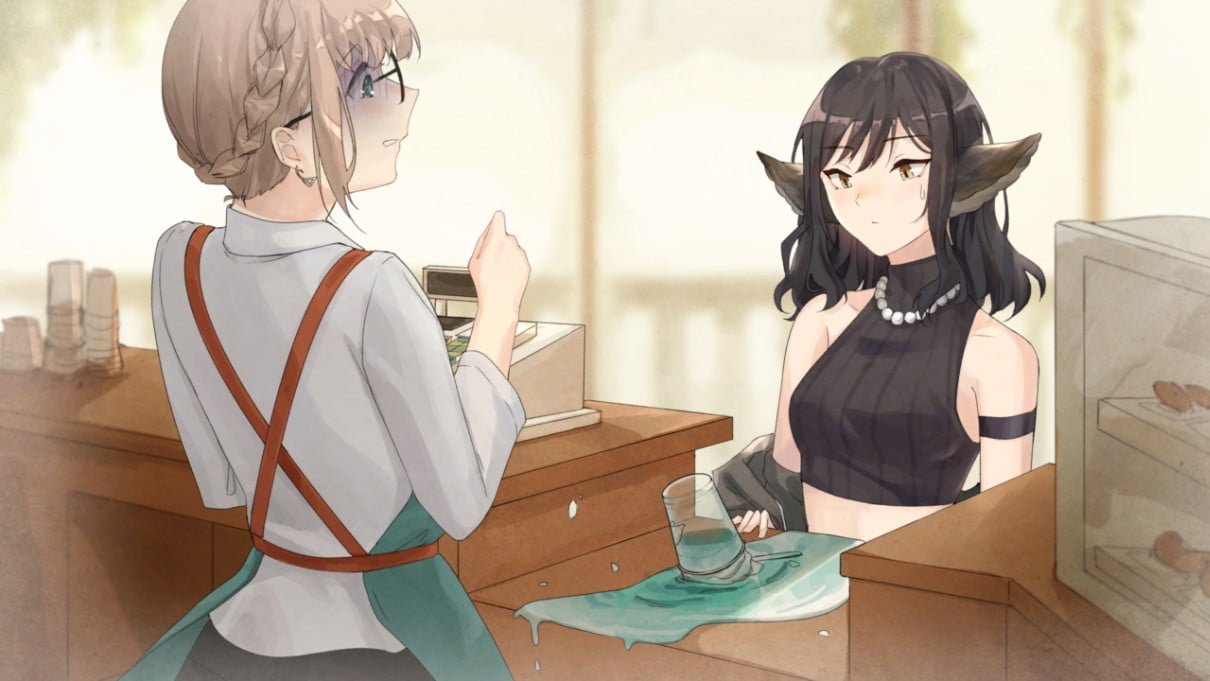
Visuals
Please Be Happy is a pretty significant departure stylistically from Studio Élan’s previous works, and it’s stunning. Menus, character art, and backgrounds are all lovingly crafted. The game is defined by a soft hand-drawn aesthetic, with rough paper textures for menus, and gentle strokes and colors for background art. Please Be Happy’s aesthetic lines up perfectly with its intended tone, the artwork is relaxed and breezy but still capable of capturing strong emotional overtones in the game’s more dramatic moments.
The visual element that stuck out the most to me was the background art. Please Be Happy’s backgrounds aren’t overly technical, often featuring rough lines and sparse detail but that isn’t a bad thing at all here. The softer features and abstraction of details in the environment give the art a dreamlike quality. It’s as if I’m seeing someone’s memory of Wellington which I think fits the themes of Please Be Happy a lot better than a more clinical and precise recreation. The softness of the backgrounds also lets the character art pop better with their more detailed designs.
Those character designs are another significant strength of Please Be Happy. Character art blends naturally with the environment whilst conveying a real sense of personality and place. Where these designs shine brightest is in the collection of CGs that accompany important story beats, with a tight focus on conveying the emotion and impact of a scene elevating the already beautiful art. It appears to me that a great deal of effort was made to bring these characters and the world they inhabit to life, and after several playthroughs, I can say with certainty that the art is my favourite element of Please Be Happy.

Story
Perhaps not the best idea to discuss my favourite element so early, but there is still a lot to appreciate outside of the visuals. Being nice and pretty is one thing, but it’s the writing that makes or breaks a visual novel. Thankfully, Please Be Happy manages to tell a heartfelt and impactful story with strong character writing and a commitment to clarity that I think is commendable.
The story follows Miho, a girl who was once just a fox, now a fox and a girl, a gumiho. Gumiho are a Korean mythical creature that I know very little about, but Please Be Happy has its own take on their nature so foreknowledge is not required. Miho arrives in Wellington as a true outsider. Unable to fit herself into society, she survives as a thief whilst she searches for the person who saved her life when she was still just a fox.
In Wellington, Miho meets Aspen, a kind and bright young woman who is trying to make it as an author, and Juliet, a caring but reserved vampire lady that runs Wellington’s local library. These are Please Be Happy’s two potential romantic partners for Miho, and as she becomes closer with them and a selection of Wellington’s other residents the mysteries of her nature and past are unravelled, and possible futures for her life begin to take shape.
The story is at its best in the opening hours whilst Miho is living as a thief and trying her best to avoid getting drawn into the community. Miho’s fear of others, combined with the bitter sense of loneliness that lingers in her daily life, makes for some excellent character writing and storytelling. The strength of these opening hours go a long way to defining Miho’s character and providing an understanding of her experience for the player as the rest of the story plays out.
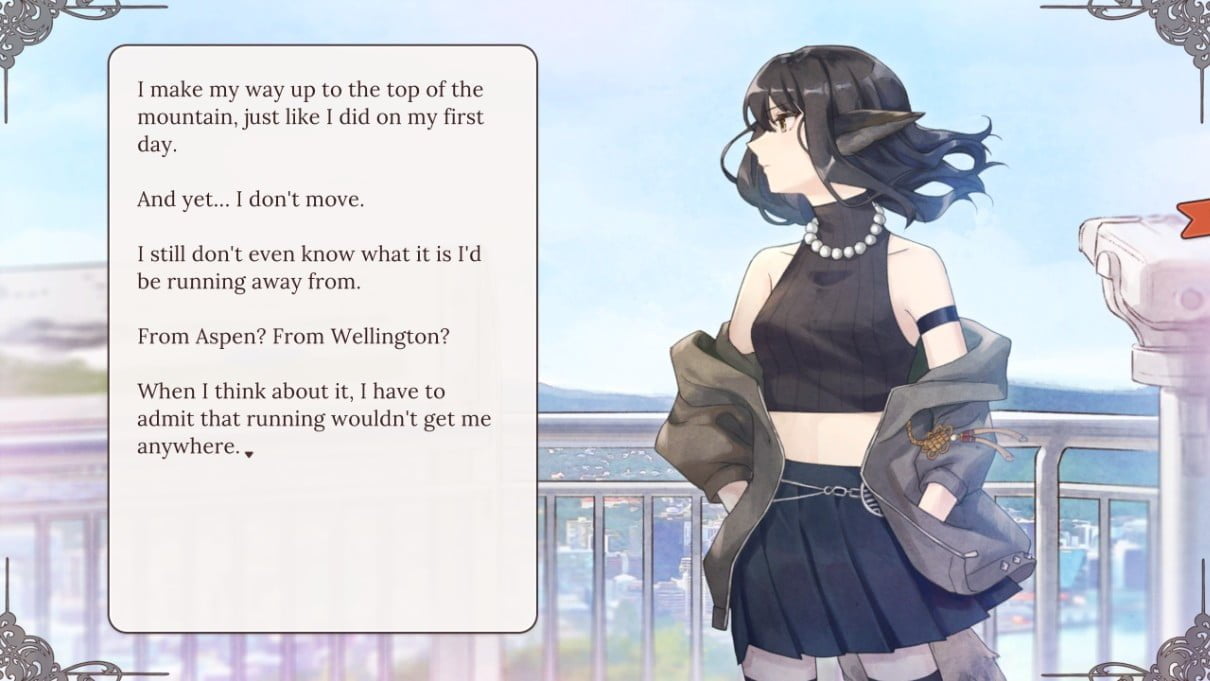
Writing
It isn’t uncommon for visual novels to lean on contrivance and abstraction, not as a tool but as a crutch to cover for a lack of clear narrative direction. Please Be Happy avoids some of the more common narrative pitfalls of visual novels thanks to a clear vision and design for the story it’s telling. There is no contrived conflict from miscommunication, instead characters take time to understand each other and communicate their own feelings clearly. There is a real humanity and honesty to Please Be Happy’s narrative that I appreciate.
The story sets out to explore some themes that are, I think, pretty universal. Questions of belonging, finding and losing friendships, and understanding your own identity. Please Be Happy doesn’t sideline these themes, they’re tied directly into the plot and given plenty of attention. The protagonist Miho is, by her nature, an outsider in Wellington. At the outset she isn’t human, but she isn’t an animal either. She is afflicted by a magic that means she is forgotten by anyone who meets her after twenty-four hours pass without seeing her. She doesn’t have a place in the world, but she does need one and I’d say that’s the central conflict of Please Be Happy.
Miho’s circumstances are essentially a more concrete and extreme version of the kind of loneliness or loss of place that one might experience at many points in life. Moving to a new place, friends coming and going over time, or the world changing faster than you can keep up. I’d hazard a guess that almost everyone has some experience of this nature, and so I expect would find Please Be Happy’s themes easy to relate to and interesting to explore.

Characters & Mood
Part of Miho finding a purpose and place is her interactions with Wellington’s delightful cast of characters. As Miho gets closer to the cast you begin to get a better idea of her character, and that same process of discovery is happening for Miho which keeps you in tune with her story and struggles. I never felt frustrated by Miho’s actions or feelings, Please Be Happy takes care to make sure the player is mostly on the same page with the lead throughout.
Where the narrative falls out of rhythm somewhat is with the two romantic interests, Aspen and Juliet. These characters are charming and do have the kind of magnetism you’d hope for, but their relationships with Miho don’t come across all that well. This is to some extent an issue of length, there isn’t enough time spent to develop the relationships between Miho, Aspen, and Juliet. But there is also just a general lack of romantic tension in the writing, particularly with Juliet.
Juliet and Aspen are both easy to become invested in, each possessed of their own quirks and conflicts, but there isn’t much of a reason as far as I can tell that they become attached to Miho or vice versa. Whilst playing their respective routes I was sometimes left to wonder, why do these characters love each other? And the only clear answer I could find was: because they do. I suppose it’s quite realistic in a sense, but it’s not narratively satisfying. Romance needs a degree of tension and excitement, ups and downs, and maybe some ambiguity, but none of that is present here. The romantic routes felt more like straightforward paths to an inevitable conclusion.
This same issue is present in general across Please Be Happy’s narrative. There is a lack of tension, owing perhaps to the game’s overall cozy vibe. The stakes aren’t low, but the list of potential bad outcomes are all quite low-impact. Tragic possibilities linger on the edges of the narrative, but they’re more subtle tragedies that lend themselves to melancholy rather than woe. There is also a sense that there isn’t actually a risk of these tragedies materializing; the relaxed and lighthearted mood the game sets precludes real drama. This isn’t necessarily a bad thing I suppose, but it does cause the narrative to drag at times. Please Be Happy is a laid-back experience, and that’s risky as there’s not much space between laid-back and flat on your ass.
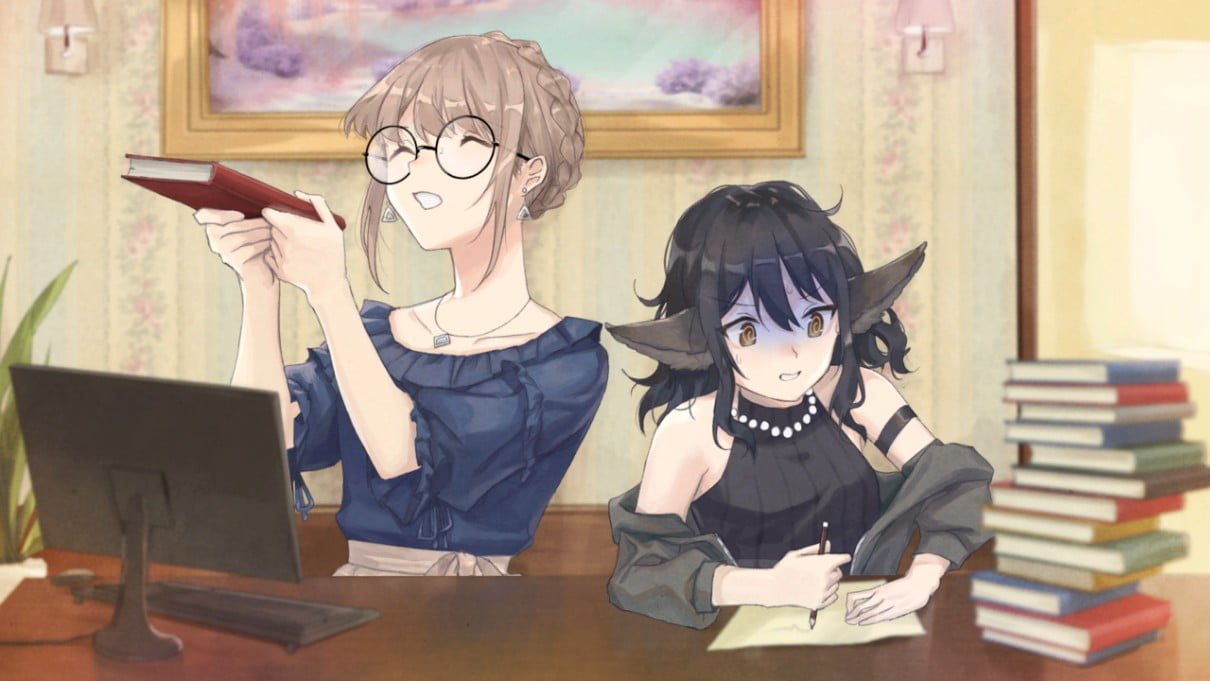
Length & Variety
Please Be Happy has two routes, one for each romantic interest. The branching point comes in Chapter 3 and beyond some small scene changes those first three chapters will play out the exact same way regardless of some choices you’re offered. Once you’re on a route there are two endings to pursue, but it is just endings with no variation in-route based on your choices. Personally, I don’t see this as a positive or negative, it’s just a function of Please Be Happy’s narrative, but if you’re the kind of player who likes big branching routes and dialogue trees then perhaps look elsewhere. And if you just want to head directly to the ending you want, perhaps check out our guide.
In truth, I think Please Be Happy would have worked just as well if not better as a kinetic novel. The only real choice here is between Aspen and Juliet as romantic partners, and whilst both routes had some heartwarming moments I think you could have achieved the same feeling with just one route. Aspen in particular felt like the more thematically appropriate choice and the strengths of Juliet’s route aren’t reliant on a romantic pretext. Narrowing the scope would also allow room for the romantic slow-burn I think is missing here.
That said, Please Be Happy isn’t overly long so it’s not as though cuts are necessary here. It took me fifteen hours to read through both routes and see all the endings and side stories, though your experience may differ depending on reading speed and whether or not you choose to reread the first three chapters on the second route. An extra chapter dedicated to fleshing out the romantic elements would, I think, have made the narrative stronger overall but I suppose it could have also hurt the pace somewhat. It’s not that Please Be Happy feels incomplete, I just can’t get past this lingering feeling that a little bit more time with its cast could have pulled everything together even better.
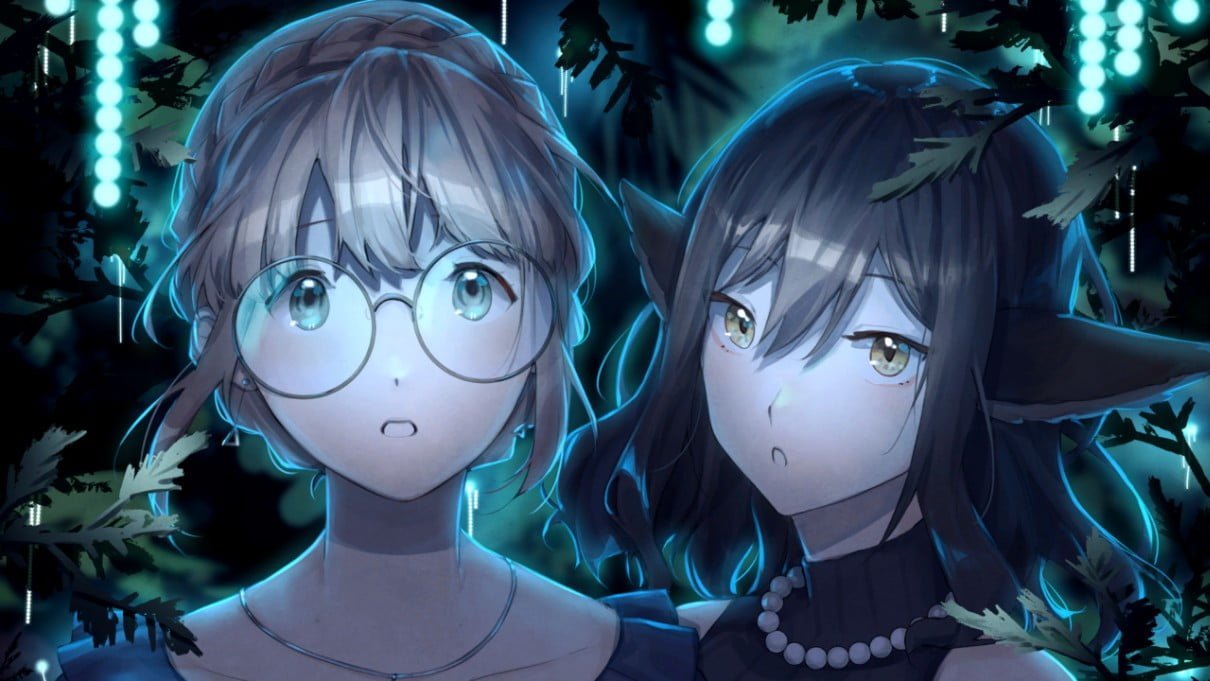
VA & Music
Please Be Happy features full English voice acting. All dialogue is voiced even interjections from nameless, faceless background people. The voice cast deserves a lot of praise. Without the voice cast’s efforts to bring life to the characters, some of the narrative’s issues would have appeared more severe. I will say I was taken aback at first by some of the voices, but as I became more familiar with the characters their respective voices came to fit like a glove. Miho’s VA in particular elevates so much of Please Be Happy’s narrative, with their light and dynamic voice giving Miho a magnetic energy that I adored. My only complaint with the VA work is more an issue of direction. There were times where voice lines didn’t match up in mood with the dialogue and character expressions; they were never completely off-base but when this happened the lines did fall flat.
The soundtrack is put together beautifully and integrates seamlessly with Please Be Happy’s narrative and tone. There is a smooth and soft quality to the music that settles you gently into Wellington and puts you at ease in a way that might seem simple but I suspect is actually quite difficult to pull off. For what it’s worth I’ve been listening to the OST and humming some of the tracks incessantly for the last few days, which is rare for me. Flyleaf and The Fox of Fable are two excellent tracks from the OST worth having a listen to if you’re thinking of picking up Please Be Happy and want to get a sense for its atmosphere and vibe.
One issue with sound I did notice is that overall Please Be Happy is quiet. Not a huge issue by any means but where as I usually cap out volume at around 40% on my speakers I had to push this up to 80%. I experimented a bit with headphones and different speakers and as far as I can tell this is just an issue with the game’s mix, but I leave open the possibility that it’s a bug of some kind that may not affect everyone. Regardless, it’s a small issue and one that I imagine the vast majority will not have any trouble resolving themselves.

Verdict
If you’re here for romance I suspect you may be disappointed. There isn’t enough strength in the romantic writing for me to recommend it on that basis. Really Please Be Happy is more story than yuri. I was pleased and engaged by the experience but I do think it’s important to go in with the appropriate expectations. Please Be Happy is light, but it isn’t disposable. If you’re looking for a relaxed slice-of-life story with some thoughtful exploration of purpose and identity, with a small helping of romance, then I think Please Be Happy is a safe bet. If nothing else the wonderful art and music justify the price tag in my book.
PLEASE BE HAPPY IS RECOMMENDED

Guide Link: Click Here
Want to check out more visual novels? Why not check out our review of OshiRabu: Waifus Over Husbandos?
Many thanks go to Studio Élan for a PC review code for this title.
A man described by critics as “pretty normal” and “memorable in the abstract”. He has committed his life to the consumption of anime and games, against the advice and wishes of his family and friends. Now writing about his passions, hopefully for your enjoyment.

